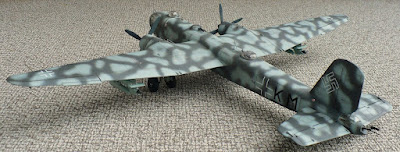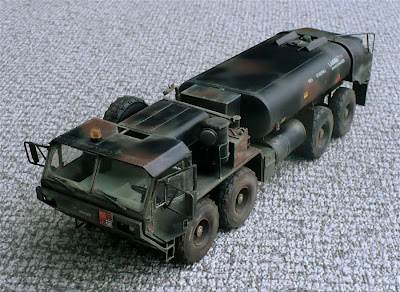




 Here are some images of another 1/35 scale Sd. Kfz. 166 Sturmpanzer 43 from Tamiya. From Wikipedia "
Here are some images of another 1/35 scale Sd. Kfz. 166 Sturmpanzer 43 from Tamiya. From Wikipedia " The Sturmpanzer IV was a development of the Panzer IV tank designed to provide direct infantry fire support, especially in urban areas. The result was the Sturmpanzer IV, which used a Panzer IV chassis with the upper hull and turret replaced by a new casemate-style armored superstructure housing a new gun, the 15 centimetres (5.9 in) Sturmhaubitze (StuH) 43 L/12 developed by Skoda. It fired the same shells as the 15 cm sIG 33 heavy infantry gun. Thirty-eight rounds, with separate propellant cartridges, could be carried. It used the Sfl.Zf. 1a sight. A MG 34 machine gun was carried that could be fastened to the open gunner's hatch, much like the arrangement on the Sturmgeschütz III Ausf. G. Early vehicles carried a MP 40 sub-machine gun inside, which could be fired through firing ports in the side of the superstructure.
The driver's station projected forward from the sloped frontal armor plate and used the Tiger I's Fahrersehklappe 80 driver's sight. The fighting compartment was (badly) ventilated by natural convection, exiting out the rear of the superstructure through two armored covers. Sideskirts were fitted on all vehicles.
Early vehicles were too heavy for the chassis, which lead to frequent breakdowns of the suspension and transmission. Efforts were made to ameliorate this from the second series onwards, with some success.
In October 1943 it was decided that the StuH 43 gun needed to be redesigned to reduce its weight. A new version, some 800 kilograms (1,800 lb) lighter than the StuH 43, was built as the StuH 43/1. Some of the weight was saved by reducing the armor on the gun mount itself. This gun was used from the third production series onwards.
Zimmerit coating was applied to all vehicles until September 1944.
1st Series
Production of the first series of 60 vehicles began in April 1943. Fifty-two of these were built using new Panzer IV Ausf. G chassis and the remaining 8 from rebuilt Ausf. E and F chassis. Survivors, about half, were rebuilt beginning in December 1943; they were mostly rebuilt to 2nd series standards.
2nd Series
Production restarted in December 1943 of another 60 vehicles, using only new Ausf. H chassis, and continued until March 1944. The Stupa's baptism in combat at the Battle of Kursk proved that the driver's compartment was too lightly armored and it was reinforced. The gunner's hatch was removed and a ventilator fan was fitted, much to the relief of the crew. Internally-sprung, steel-rimmed road wheels replaced the front two rubber-rimmed road wheels in an effort to reduce the stress on the forward suspension that was only partially successful.
3rd Series
Production of the 3rd series ran from March to June 1944 with few changes from the second series. The Fahrersehklappe 80 was replaced by periscopes and the lighter StuH 43/1 was used.
4th series
The superstructure was redesigned in early 1944 for the fourth series, which used the chassis and HL120TRM112 engine of the Ausf. J, and was in production between June 1944 and March 1945. It featured a redesigned gun collar, as well as a general reduction in height of the superstructure. This redesign also introduced a ball mount in the front superstructure for a MG 34 machine gun with 600 rounds. The vehicle commander's position was modified to use the hatch of the Sturmgeschütz III Ausf. G, which could mount a machine gun for anti-aircraft defense.























































